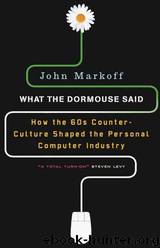What the Dormouse Said: How the Sixties Counterculture Shaped the Personal Computer Industry by John Markoff

Author:John Markoff [Markoff, John]
Language: eng
Format: mobi
Tags: Industries, Technology & Engineering, Corporate & Business History, Social Aspects, Nineteen Sixties, Computers, Computers and Civilization, General, Hardware, Microcomputers, Economic Conditions, Microcomputers - History, vl-nfcompvg, Computer Industry - History, Computer Industry, Personal Computers, Business & Economics, History
ISBN: 9780143036760
Google: cTyfxP-g2IIC
Amazon: B000IOEU90
Publisher: Penguin
Published: 2005-01-02T00:00:00+00:00
5| DEALING LIGHTNING
Doug Engelbart sat under a twenty-two-foot-high video screen, “dealing lightning with both hands.” At least that’s the way it seemed to Chuck Thacker, a young Xerox PARC computer designer who was later shown a video of the demonstration that changed the course of the computer world.1
On December 9, 1968, the oNLine System was shown publicly to the world for the first time. Encouraged by Taylor, Engelbart had chosen the annual Fall Joint Computer Conference, the computer industry’s premier gathering, for Augment’s debut. In the darkened Brooks Hall Auditorium in San Francisco, all the seats were filled, and people lined the walls. On the giant screen at his back, Engelbart demonstrated a system that seemed like science fiction to a data-processing world reared on punched cards and typewriter terminals. In one stunning ninety-minute session, he showed how it was possible to edit text on a display screen, to make hypertext links from one electronic document to another, and to mix text and graphics, and even video and graphics. He also sketched out a vision of an experimental computer network to be called ARPAnet and suggested that within a year he would be able to give the same demonstration remotely to locations across the country. In short, every significant aspect of today’s computing world was revealed in a magnificent hour and a half.
There were two things that particularly dazzled the audience on that rainy Monday morning in December 1968: First, computing had made the leap from number crunching to become a communications and information-retrieval tool. Second, the machine was being used interactively with all its resources appearing to be devoted to a single individual! It was the first time that truly personal computing had been seen.
Engelbart spoke softly in a monotone, his voice given a slightly eerie quality by the reverberations of the cavernous hall. Wearing a short-sleeved white shirt and a tie and seated at a desk on a custom-designed Herman Miller chair, he introduced the world to cyberspace. He showed the nation’s best computer scientists and hardware engineers how people would in the future work together and share complex digital information instantaneously, even though they might be a world apart.
For many who witnessed it, it was more than a bolt from the blue: It was a religious experience, inspiring the same kinds of passion that Vannevar Bush’s Memex article had given rise to for Engelbart twenty-three years earlier. Computing was just beginning to have an impact on society. Local newspaper articles that preceded the conference noted that there would be discussions of the privacy implications of the use of computers, and a public forum, “Information, Computers and the Political Process,” would feature broadcaster Edward P. Morgan and Santa Clara County’s member of the House of Representatives, Paul McCloskey Jr.
But Engelbart stole the show. In the days afterward, the published accounts of the event described nothing else. Years later, his talk remained “the mother of all demos,” in the words of Andries van Dam, a Brown University computer scientist. In many ways, it is still the most remarkable computer-technology demonstration of all time.
Download
This site does not store any files on its server. We only index and link to content provided by other sites. Please contact the content providers to delete copyright contents if any and email us, we'll remove relevant links or contents immediately.
| Automotive | Engineering |
| Transportation |
Whiskies Galore by Ian Buxton(41880)
Introduction to Aircraft Design (Cambridge Aerospace Series) by John P. Fielding(33064)
Small Unmanned Fixed-wing Aircraft Design by Andrew J. Keane Andras Sobester James P. Scanlan & András Sóbester & James P. Scanlan(32743)
Craft Beer for the Homebrewer by Michael Agnew(18140)
Turbulence by E. J. Noyes(7936)
The Complete Stick Figure Physics Tutorials by Allen Sarah(7307)
Kaplan MCAT General Chemistry Review by Kaplan(6867)
The Thirst by Nesbo Jo(6828)
Bad Blood by John Carreyrou(6552)
Modelling of Convective Heat and Mass Transfer in Rotating Flows by Igor V. Shevchuk(6391)
Learning SQL by Alan Beaulieu(6211)
Weapons of Math Destruction by Cathy O'Neil(6146)
Man-made Catastrophes and Risk Information Concealment by Dmitry Chernov & Didier Sornette(5921)
Digital Minimalism by Cal Newport;(5664)
Life 3.0: Being Human in the Age of Artificial Intelligence by Tegmark Max(5474)
iGen by Jean M. Twenge(5366)
Secrets of Antigravity Propulsion: Tesla, UFOs, and Classified Aerospace Technology by Ph.D. Paul A. Laviolette(5309)
Design of Trajectory Optimization Approach for Space Maneuver Vehicle Skip Entry Problems by Runqi Chai & Al Savvaris & Antonios Tsourdos & Senchun Chai(5011)
Pale Blue Dot by Carl Sagan(4912)
